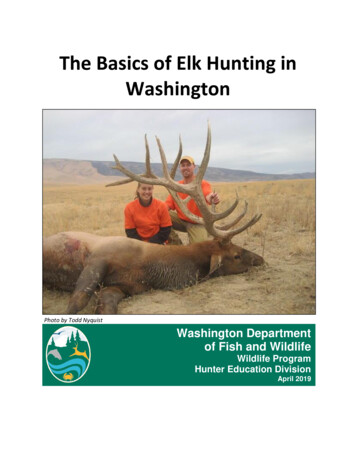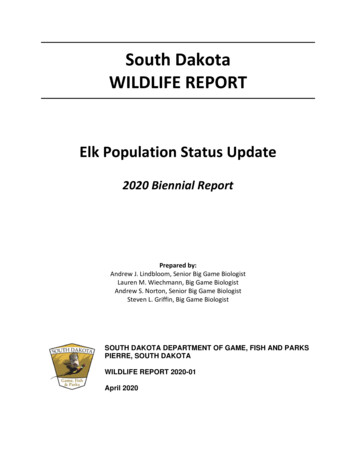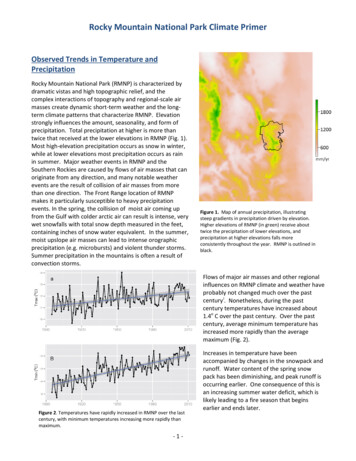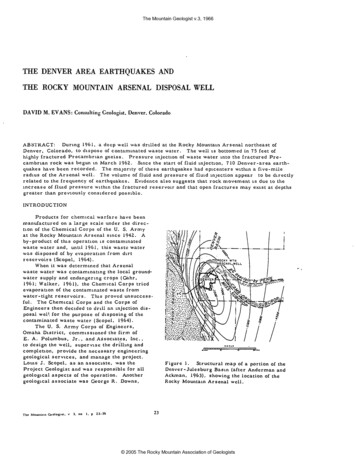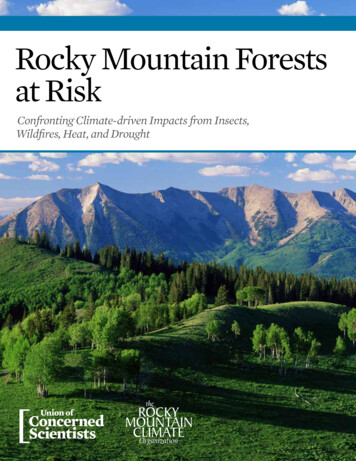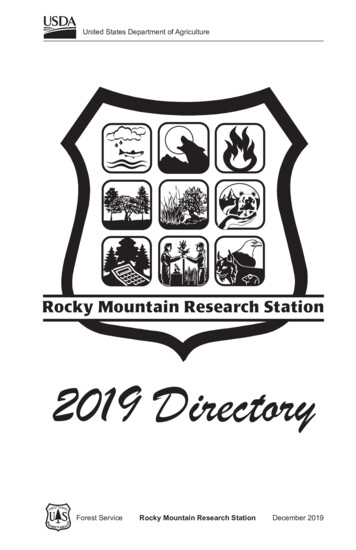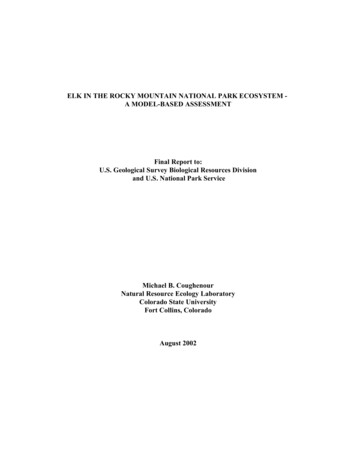
Transcription
ELK IN THE ROCKY MOUNTAIN NATIONAL PARK ECOSYSTEM A MODEL-BASED ASSESSMENTFinal Report to:U.S. Geological Survey Biological Resources Divisionand U.S. National Park ServiceMichael B. CoughenourNatural Resource Ecology LaboratoryColorado State UniversityFort Collins, ColoradoAugust 2002
TABLE OF CONTENTSEXECUTIVE SUMMARY. . . . . . . . . . . . . . . . . . . . . . . . . . . . . . . . . . . . . . . . . . . . . . . . . . . . . . . 1INTRODUCTION. . . . . . . . . . . . . . . . . . . . . . . . . . . . . . . . . . . . . . . . . . . . . . . . . . . . . . . . . . . . . 17SITE DESCRIPTION. . . . . . . . . . . . . . . . . . . . . . . . . . . . . . . . . . . . . . . . . . . . . . . . . . . . . . . . . . 24Landscape. . . . . . . . . . . . . . . . . . . . . . . . . . . . . . . . . . . . . . . . . . . . . . . . . . . . . . . . . . . . . 24Climate. . . . . . . . . . . . . . . . . . . . . . . . . . . . . . . . . . . . . . . . . . . . . . . . . . . . . . . . . . . . . . . 24Soils. . . . . . . . . . . . . . . . . . . . . . . . . . . . . . . . . . . . . . . . . . . . . . . . . . . . . . . . . . . . . . . . . . 25Vegetation. . . . . . . . . . . . . . . . . . . . . . . . . . . . . . . . . . . . . . . . . . . . . . . . . . . . . . . . . . . . . 25ECOLOGICAL HISTORY. . . . . . . . . . . . . . . . . . . . . . . . . . . . . . . . . . . . . . . . . . . . . . . . . . . . . . 28Evidence of Elk Prior to Euro-American Settlement. . . . . . . . . . . . . . . . . . . . . . . . . . . . 28Elk Carrying Capacity Estimates. . . . . . . . . . . . . . . . . . . . . . . . . . . . . . . . . . . . . . . . . . . . 29Elk Management. . . . . . . . . . . . . . . . . . . . . . . . . . . . . . . . . . . . . . . . . . . . . . . . . . . . . . . . 30Upland Herbaceous and Shrub Communities. . . . . . . . . . . . . . . . . . . . . . . . . . . . . . . . . 31Aspen. . . . . . . . . . . . . . . . . . . . . . . . . . . . . . . . . . . . . . . . . . . . . . . . . . . . . . . . . . . . . . . . . 33Willow. . . . . . . . . . . . . . . . . . . . . . . . . . . . . . . . . . . . . . . . . . . . . . . . . . . . . . . . . . . . . . . . 34Beaver. . . . . . . . . . . . . . . . . . . . . . . . . . . . . . . . . . . . . . . . . . . . . . . . . . . . . . . . . . . . . . . . 35VEGETATION MAP. . . . . . . . . . . . . . . . . . . . . . . . . . . . . . . . . . . . . . . . . . . . . . . . . . . . . . . . . . 37MODEL DESCRIPTION AND DATA INPUTS. . . . . . . . . . . . . . . . . . . . . . . . . . . . . . . . . . . . . 40Ecosystem Model Structure. . . . . . . . . . . . . . . . . . . . . . . . . . . . . . . . . . . . . . . . . . . . . . . . 40Weather. . . . . . . . . . . . . . . . . . . . . . . . . . . . . . . . . . . . . . . . . . . . . . . . . . . . . . . . . . . . . . . 41Water Submodels and Soil Properties. . . . . . . . . . . . . . . . . . . . . . . . . . . . . . . . . . . . . . . . 42Microclimate and Light. . . . . . . . . . . . . . . . . . . . . . . . . . . . . . . . . . . . . . . . . . . . . . . . . . . 44Plant Biomass Production. . . . . . . . . . . . . . . . . . . . . . . . . . . . . . . . . . . . . . . . . . . . . . . . . 45Plant Populations. . . . . . . . . . . . . . . . . . . . . . . . . . . . . . . . . . . . . . . . . . . . . . . . . . . . . . . . 47Vegetation Management. . . . . . . . . . . . . . . . . . . . . . . . . . . . . . . . . . . . . . . . . . . . . . . . . . 47Litter Decomposition, N Cycling, and Soil Organic Matter Dynamics. . . . . . . . . . . . . . . 48Herbivore Forage Intake. . . . . . . . . . . . . . . . . . . . . . . . . . . . . . . . . . . . . . . . . . . . . . . . . . 49Herbivore Energy Balance. . . . . . . . . . . . . . . . . . . . . . . . . . . . . . . . . . . . . . . . . . . . . . . . . 51Herbivore Population Dynamics. . . . . . . . . . . . . . . . . . . . . . . . . . . . . . . . . . . . . . . . . . . . 52Herbivore Spatial Distribution. . . . . . . . . . . . . . . . . . . . . . . . . . . . . . . . . . . . . . . . . . . . . 54Wolf Population Dynamics and Predation. . . . . . . . . . . . . . . . . . . . . . . . . . . . . . . . . . . . 55Population Dynamics. . . . . . . . . . . . . . . . . . . . . . . . . . . . . . . . . . . . . . . . . . . . . . . 56Predation. . . . . . . . . . . . . . . . . . . . . . . . . . . . . . . . . . . . . . . . . . . . . . . . . . . . . . . . 57MODEL VERIFICATION - PLANT BIOMASS. . . . . . . . . . . . . . . . . . . . . . . . . . . . . . . . . . . . 60Herbaceous Biomass Production. . . . . . . . . . . . . . . . . . . . . . . . . . . . . . . . . . . . . . . . . . . . 60Willow and Upland Shrub Production. . . . . . . . . . . . . . . . . . . . . . . . . . . . . . . . . . . . . . . 63Summary. . . . . . . . . . . . . . . . . . . . . . . . . . . . . . . . . . . . . . . . . . . . . . . . . . . . . . . . . . . . . . 64
MODEL VERIFICATION - THE CONTROL RUN FOR 1949-1998. . . . . . . . . . . . . . . . . . . . . 65Description. . . . . . . . . . . . . . . . . . . . . . . . . . . . . . . . . . . . . . . . . . . . . . . . . . . . . . . . . . . . 65Precipitation and Snow. . . . . . . . . . . . . . . . . . . . . . . . . . . . . . . . . . . . . . . . . . . . . . . . . . . 65Hydrology. . . . . . . . . . . . . . . . . . . . . . . . . . . . . . . . . . . . . . . . . . . . . . . . . . . . . . . . . . . . . 66Elk populations and spatial distributions. . . . . . . . . . . . . . . . . . . . . . . . . . . . . . . . . . . . . . 67Plant production and offtake. . . . . . . . . . . . . . . . . . . . . . . . . . . . . . . . . . . . . . . . . . . . . . . 68Herbivore diets, forage intake rates, and condition indices. . . . . . . . . . . . . . . . . . . . . . . . 70Soil Carbon and Nitrogen. . . . . . . . . . . . . . . . . . . . . . . . . . . . . . . . . . . . . . . . . . . . . . . . . 71Summary. . . . . . . . . . . . . . . . . . . . . . . . . . . . . . . . . . . . . . . . . . . . . . . . . . . . . . . . . . . . . . 71MODEL EXPERIMENTS. . . . . . . . . . . . . . . . . . . . . . . . . . . . . . . . . . . . . . . . . . . . . . . . . . . . . . 731775-1911. . . . . . . . . . . . . . . . . . . . . . . . . . . . . . . . . . . . . . . . . . . . . . . . . . . . . . . . . . . . . 731912-1948. . . . . . . . . . . . . . . . . . . . . . . . . . . . . . . . . . . . . . . . . . . . . . . . . . . . . . . . . . . . . 761949-1998. . . . . . . . . . . . . . . . . . . . . . . . . . . . . . . . . . . . . . . . . . . . . . . . . . . . . . . . . . . . . 80Factorial Experiment on Plant Responses to Elk, Beaver, and Water Tables. . . . . . . . . . 84Elk and Vegetation Management Scenarios. . . . . . . . . . . . . . . . . . . . . . . . . . . . . . . . . . . 86Hypothetical Scenarios with Wolves. . . . . . . . . . . . . . . . . . . . . . . . . . . . . . . . . . . . . . . . . 90Sensitivity Analysis of Wolf Model Parameters. . . . . . . . . . . . . . . . . . . . . . . . . . . . . . . . 90DISCUSSION. . . . . . . . . . . . . . . . . . . . . . . . . . . . . . . . . . . . . . . . . . . . . . . . . . . . . . . . . . . . . . . . 921775-1911. . . . . . . . . . . . . . . . . . . . . . . . . . . . . . . . . . . . . . . . . . . . . . . . . . . . . . . . . . . . . 921912-1948. . . . . . . . . . . . . . . . . . . . . . . . . . . . . . . . . . . . . . . . . . . . . . . . . . . . . . . . . . . . . 931949-1998. . . . . . . . . . . . . . . . . . . . . . . . . . . . . . . . . . . . . . . . . . . . . . . . . . . . . . . . . . . . . 96Responses during elk reductions. . . . . . . . . . . . . . . . . . . . . . . . . . . . . . . . . . . . . . 96Upland responses after the cessation of reductions. . . . . . . . . . . . . . . . . . . . . . . . 97Aspen. . . . . . . . . . . . . . . . . . . . . . . . . . . . . . . . . . . . . . . . . . . . . . . . . . . . . . . . . . . . . . . . . 98The “Town” Elk. . . . . . . . . . . . . . . . . . . . . . . . . . . . . . . . . . . . . . . . . . . . . . . . . . . . . . . 100Willow, Beaver and Hydrology. . . . . . . . . . . . . . . . . . . . . . . . . . . . . . . . . . . . . . . . . . . . 101Soil Organic Matter, Nitrogen Cycling, and N Limitation of Ungulates. . . . . . . . . . . . . 104Elk and Vegetation Management Scenarios. . . . . . . . . . . . . . . . . . . . . . . . . . . . . . . . . . 107Wolf Model Uncertainties. . . . . . . . . . . . . . . . . . . . . . . . . . . . . . . . . . . . . . . . . . . . . . . . 110Trophic Interactions. . . . . . . . . . . . . . . . . . . . . . . . . . . . . . . . . . . . . . . . . . . . . . . . . . . . . 112Aboriginal Hunting. . . . . . . . . . . . . . . . . . . . . . . . . . . . . . . . . . . . . . . . . . . . . . . . . . . . . 114Lack of Bison. . . . . . . . . . . . . . . . . . . . . . . . . . . . . . . . . . . . . . . . . . . . . . . . . . . . . . . . . . 115CONCLUSIONS AND IMPLICATIONS FOR MANAGEMENT AND POLICY. . . . . . . . . . 117ACKNOWLEDGMENTS. . . . . . . . . . . . . . . . . . . . . . . . . . . . . . . . . . . . . . . . . . . . . . . . . . . . . . 120REFERENCES. . . . . . . . . . . . . . . . . . . . . . . . . . . . . . . . . . . . . . . . . . . . . . . . . . . . . . . . . . . . . . 121
EXECUTIVE SUMMARYRocky Mountain National Park (RMNP) was established after a period of substantialresource extraction by early settlers, including trappers, hunters, miners, loggers, and ranchers. Aonce abundant large herbivore, elk (Cervus elaphus) had by that time been extirpated from theregion by a period of intensive market hunting in the 1860s and 1870s (Guse 1966). Mule deer(Odocoileus hemionus) were also much reduced. Elk were reintroduced in 1913-1914, and thepopulation grew in size to approximately 900 animals in 1938-1939 (Packard 1947a). Elk wereintensively managed from 1944-1968, due to early concerns that they were overabundant, anddamaging the winter range. The herd was reduced by culling operations in 1944-1945 and 19491950, and generally kept in the 300-600 range through 1968. Public disapproval of elk culling inYellowstone led to an experimental approach to management often referred to as naturalregulation. The hypothesis was that elk would reach a natural food-limited carrying capacity, andpopulation growth would be self-regulated through density-dependent competition for food.Since 1968, the elk herd in RMNP has been managed only by sport hunting outside of the parkboundary, which has not controlled elk population growth. Furthermore, elk have beenincreasingly wintering outside the park boundaries in the town of Estes Park, where they alsolargely escape hunting.Concerns about elk impacts on plants and other components of the ecosystem haveheightened considerably during the last two decades (Olmsted 1977, 1979, 1997, Hess 1993,Wagner et al. 1995, Baker et al. 1997, Berry et al. 1997, Keigley and Wagner 1998). In particular,it has been suggested that elk are overabundant and present in unnatural densities due to lack ofnatural predators and Native American hunting. These authors felt that in pre-settlement times,elk were present at much lower densities, and they may not have wintered in the areas which nowcomprise RMNP. However, there appears to be no evidence that elk did not winter on the easternslope of the park in historic times.An effort was made to review the literature for prehistoric and historic elk presence.Prehistoric game drive systems discovered at high elevations within the park were most likelyused to hunt elk (Benedict 1992, 1999). There was a considerable amount of historical evidenceof elk presence prior to settlement (Sage 1846, Loring 1893, Sprague 1925, Fryxell 1928, Estes1939).Human impacts on the elk winter range prior to the creation of the national park providedan unnatural starting point for the elk reintroduction program, and likely exacerbated elk impactson the range. Livestock grazing was widespread and apparently intense enough to causesignificant changes in herbaceous vegetation cover (Mills 1924, McLaughlin 1931, Ratcliff1941). Land had also been drained and willows cut to support haying operations (Gysel 1960).A deer eruption in the 1930s, along with increased numbers of elk brought about declinesin upland shrubs (Ratcliff 1941), willow cover (Dixon 1939, Gysel 1960), and barking and1
suppression of regeneration in aspen (McLaughlin 1931, Ratcliff 1941, Packard 1942). Followingthe elk reduction programs of the 1940s, Buttery (1955) concluded that range condition hadimproved to fair condition, and was stable. After the cessation of elk reductions, Stevens (1980)found stable sagebrush grasslands, but increases in bare ground in grasslands between 19681979. Stohlgren et al. (1999) found grazing reduced herbaceous cover slightly, and increaseddiversity.A greater level of concern has been recently expressed about elk impacts on riparianwillow communities, beaver, and aspen. Aspen stands on the winter range have exhibited little orno regeneration, heavy bark scarring, and mortality (Olmsted 1979, 1997, Stevens 1980, Baker etal. 1997), all attributable to elk browsing. A recent analysis of historical aerial photographyshowed that over the last 50-59 years willow cover has declined by 19-21% (Peinetti 2000,Peinetti et al. 2002). These decreases were associated with 44-56% decreases in total streamchannel density, which was believed to be a consequence of reduced beaver activity. Beavershave declined both on and off the winter range from high levels in 1925-1947 (Warren 1926,Packard 1947b) to current densities which are apparently 90% less than in 1940 (Hickman 1964,Stevens and Christianson 1980, Gense 1997, Zeigenfuss et al. 2002). Some authors haveattributed the decline to elk, particularly their negative impacts on willow (Packard 1947b, Gysel1960, Hess 1993). However, beaver numbers first declined when elk were being controlledbelow their food-limited carrying capacity.These concerns led to the inception of several new studies of the elk winter range,including the present study. A three-year study of elk impacts on upland grasslands andshrublands has shown little impact of herbivory (Singer et al. 2001a). Few effects have beennoted of elk on soil carbon and nitrogen or herbaceous root biomass (Binkley et al. 2002,Schoenecker et al. 2002), however, in willow communities Schoenecker et al. (2002) foundmarkedly (5x) lower N mineralization outside short-term exclosures located in portions of thewinter range judged to have high elk densities. All of the sites were in browsing-suppressed shortwillow communities. A five-year study of elk browsing impacts on willow (Peinetti 2000, Singeret al. 2001a,b; 2002; Zeigenfuss et .al. 2002) has shown large increases in willow growth whenprotected from elk herbivory. Zeigenfuss et al. (1999) found a continuation of some of thenegative vegetation trends observed earlier by Stevens (1980). Olmsted (1997) found furtherevidence that aspen stands were degrading. Berry et al. (1997) examined whether vegetation onthe elk winter range has deviated from pre-Columbian conditions due to elk overabundance.They concluded elk were responsible for aspen and willow declines and decreases in uplandrange condition, and suggested that the vegetation be protected from herbivory to facilitaterecovery from past damage.The present modeling study was initiated with the specific aims of estimating elkcarrying capacity and elk impacts on riparian willow. The more general purpose of this researchwas to assess the role of elk in the RMNP ecosystem. Ecosystem modeling was used to assess therole of elk in the ecosystem, and the ways that ecosystem dynamics have been altered byinteractions between elk, climate, and humans. Ecosystem modeling is a comprehensive2
approach to carrying capacity assessment. It simultaneously addresses different concepts ofcarrying capacity by explaining ecosystem dynamics in terms of underlying ecosystem processes.The model was used to represent plant and soil responses to herbivory, food limitation of theherbivore population, and predation. It was used to project ecosystem dynamics under past,present, and future management scenarios.Model Description and Data InputsSAVANNA is a spatially explicit, process-oriented model of grassland, shrubland, savanna,and forested ecosystems developed originally for studies in East Africa (Coughenour 1992, 1993).The model has also been applied to Elk Island National Park in Alberta (Buckley et al. 1995),Yellowstone National Park (Coughenour and Singer 1996), the Pryor Mountain Wild Horse Range,Montana (Coughenour 2000), northern Australia (Ludwig et al. 1999), South Africa (Kiker 1998),Tanzania (Boone et al. 2001), and Inner Mongolia (Christiansen 2001). SAVANNA simulatesprocesses at landscape through regional spatial scales over annual to decadal time scales. The modelis composed of site water balance, plant biomass production, plant population dynamics, litterdecomposition and nitrogen cycling, ungulate herbivory, ungulate spatial distribution, ungulateenergy balance, and ungulate population dynamics submodels. Wolf predation and wolf populationdynamics submodels are derived from a model used to assess wolf reintroduction into YellowstoneNational Park (Boyce and Gaillard 1992, Boyce 1993).The model was driven by weather data from weather stations in and surrounding the studyarea. Monthly precipitation and temperature maps were generated from spatial interpolation onelevation corrected data. Historical weather data since 1949 were readily available. Data for 19311948 were sparse, however there were key stations with data, including Estes Park, Grand Lake, andFraser. Data for the period 1910-1930 were reconstructed based upon deviations from normalobserved in the data from Fraser Colorado, which had the most reliable and longest record. Data forthe period 1775-1911 were reconstructed from the tree-ring data base of Fritts (1991a,b).SAVANNA requires a vegetation map for the initialization of plant biomass and populationvariables. A single-source vegetation map for the entire elk range did not exist, primarily becausethe elk range extends outside the park boundaries, and includes land from three administrativeagencies, the U.S. National Park Service, the U.S. Forest Service (USFS), and the Town of EstesPark. Consequently, a vegetation map was constructed from multiple sources. Vegetation cover mapsfrom RMNP and the Arapahoe-Roosevelt National Forest (ARNF) were combined into a singlecoverage (Ron Thomas RMNP GIS lab). Vegetation outside RMNP and ARNF, i.e., on privatelandholdings, was derived from a vegetation map of Larimer County Colorado that was developedat Colorado State University from a Landsat-TM scene (McCool 1995, Todd 1995). Disturbed areas,human land uses and areas subsidized by water, were delimited with the aid of satellite data of thenormalized difference vegetation index (NDVI). An “undisturbed” vegetation map was created torepresent the vegetation cover prior to the settlement of the Estes Valley. Vegetation and land coversof anthropogenic origin on the Larimer County vegetation map were restored to undisturbedconditions. All areas classified as disturbed, urban, golf course, etc., were reclassified as grassland.3
The Big Thompson river course was markedly altered by development, including the constructionof a dam and lake. Historical photographs of the valley prior to town and dam construction showedthe former extent of the river course and riparian floodplain. These features were incorporated intothe “undisturbed” vegetation map.The model was configured to represent ten plant functional groups: upland grasses and forbs,riparian graminoids and forbs, upland shrubs, willow, aspen, ponderosa pine/Douglas fir, lodgepolepine, and subalpine conifers (spruce-fir). The area that was simulated was defined by the combinedwinter and summer ranges of the elk which winter on the east slope of RMNP, and in the town ofEstes Park. Two subherds of elk were simulated, a park subherd and a town subherd, based oninformation that animals from these subherds exhibit fidelity to these ranges (Lubow et al. 2002).Mule deer were also simulated, primarily to represent their impacts on plants. Their range wasassumed to be the elk-defined study area, but with different habitat preferences.The plant growth model was parameterized from numerous data sources in the literature, andfrom recent field studies in RMNP. Then it was verified by comparing model outputs to observedbiomass data from Hobbs (1979), Fisk et al. (1998), Singer et al. (2001a,2002), and Zeigenfuss et.al. (2002). Comparisons were made for several major vegetation types including: dry grasslands,mesic riparian herbaceous, upland shrubs, willow, low elevation woodlands dominated by ponderosapine (montane woodland), high elevation woodland and forest dominated by lodgepole pine,Engelmann spruce and subalpine fir, and alpine tundra. Comparisons were made under grazed andungrazed conditions. The comparisons proved to be generally favorable.Model Verification – the Control Run for 1949-1998A simulation was conducted to represent observed ecosystem dynamics for the period 19491998. This was referred to as the control run because it represented a set of standard conditions towhich results from other model experiments could be compared. Control run output providedadditional information for verifying the model’s behavior by comparing simulation results toobservations. The control run was a calibration run for animal submodels, because key modelparameters for diet selection, forage intake, energy use, and population dynamics were calibrated sothat model outputs most closely matched observed values.The simulated elk population was reduced using observed rates of elk offtake by hunterharvest and management removals. The deer population was maintained within a range of 400-600animals throughout the simulation by removals as necessary.The snow submodel was verified by comparisons between observed and predicted data atseven SNOTEL stations 1979-1998. The snow model performed satisfactorily at most of the sites.Water table depths in riparian willow stands (Singer et al. 1999, Zeigenfuss et al. 2002) wereused to parameterize model relationships between water table depth and streamflow in the4
watershed. These relationships were then used in the model to estimate water table depths fordifferent willow sites within each watershed.The elk population model was calibrated to observed, sightability-corrected count data 19591998 (Lubow et al. 2002). The model was calibrated to pass through the higher of the reasonable datapoints, on the assumption that lower values were undercounts. The model simulated the correct rateof population increase, and most importantly, represented the leveling-off of the park populationduring 1980-1998. This indicates that the model was representing density dependent competition forfood, and thus food-limited carrying capacity, correctly. There was a clear decline in the ratio ofcalves to cows over the period 1949-1998. This was consistent with data, and with the hypothesisthat the elk population was exhibiting a density-dependent limitation on recruitment (Lubow et al2001).Simulated spatial distributions of elk were in agreement with observed data. High densitiesof up to 90 elk/km2 were simulated in the Moraine Park area. High densities were also simulated incertain areas of Horseshoe Park, but overall density was less than in Moraine Park. These densitiesare consistent with the contour maps generated from aerial survey data (Singer et al. 2002), whichshow density contours of 12-16 elk/km2 in Horseshoe Park and 90 elk/km2 in Moraine Park.Simulated elk diets were consistent with data of Riorden (1948), Hobbs (1979), Stevens(1980), Baker and Hobbs (1982), and Singer et al. (2001b).The model predicted a reasonable spatial distribution of herbaceous biomass over the winterand summer ranges. Peak biomass generally ranged 40-150 g/m2 on the winter range on grassland,shrubland, and ponderosa pine woodlands. Low production was simulated in the subalpine forests(20-40 g/m2). Higher biomass levels were simulated on the alpine tundra and subalpine meadows.Aboveground net primary production was not much higher than peak standing crop.Condition indices of elk reached maximum values each summer. End of winter minimadeclined over the period in response to increasing density and competition for limited forage. Therewas considerable variability among winters, reflecting differences in winter severity, and foragingconditions. Condition indices of the town population showed a similar pattern, but when densitieswere extremely low, winter minima were much higher than observed in the park population. As thetown population increased, winter minima decreased markedly.Model ExperimentsModel experiments were conducted for three different time periods: 1775-1911, 1912-1948,and 1949-1998.The period before the reintroduction of elk (1775-1911) included transitions from anecosystem undisturbed by Euro-American colonists but possibly affected by Native Americans, toan ecosystem that was heavily exploited by early settlers. Beaver trapping occurred prior to 1850,5
market hunting and extirpation of elk occurred in the 1870s, followed by logging, and heavylivestock grazing throughout the Estes Valley and the elk winter range inside the current parkboundaries. Wolves were still present in 1894, but were extirpated well before 1917 (Stevens 1980).Simulation studies of this period were designed to examine the pre-settlement ecosystem, and theimpacts of these initial disturbances.The reconstructed undisturbed vegetation map was used in all of the 1775-1911 runs. Humanimpacts on ungulates were represented in the model through the imposition of prescribed huntingreductions. To reduce confounding effects, deer were kept at or below 600-700 throughout the entiresimulation. Beavers on the elk winter range inside the park were held at 450 throughout. The controlrun for this period (a run to simulate actual conditions) examined the effects of the extirpation of elkby market hunting. Experimental runs were conducted to examine undisturbed conditions assumingone elk herd, undisturbed conditions assuming two elk subherds limited to the ranges now occupiedby park and town subherds, respectively, and the effects of wolves.When the historic pattern of hunting was imposed, elk were extirpated as specified, and inresponse deer numbers increased and wolves were eliminated due to lack of prey. With no elkhunting, and with wolves (undisturbed conditions), total elk numbers varied between 1,500-3,500and gradually increased throughout the simulation. Distinguishing two subherds indicated therelative sizes of subherds that would be expected in the two ranges. The park subherd variedbetween 300-800 elk, while the town subherd varied between 1,400-1,500 elk at first, increasingto approximately 1,600-2,000 elk in later years. Deer numbers were kept to 200 by wolf predation.Without wolves, total elk numbers increased at first to about 3,800, then numbers exhibited adynamic equilibrium at approximately 2,800 elk, but with a declining long-term trend due todeteriorating range conditions. Elk numbers ended at a similar point with or without wolves, but elkand vegetation conditions were substantially improved in the presence of wolves. Elk conditionindices remained higher in winter when wolves were limiting the population compared to when foodwas limiting the population. Elk mortalities due to starvation were therefore likely to be far less withwolves present.When elk were hunted to historic levels, dryland herbaceous biomass, i.e., herbaceous layerbiomass everywhere on the park elk winter range except in riparian willow and wet meadows,increased. In undisturbed conditions (no market hunting and wolves present), dryland herbaceousbiomass increased and then decreased slightly when elk were limited by wolves. Without wolves,dryland biomass declined gradually throughout the period. With historic elk hunting, willow coverincreased to the maximum level, while with undisturbed conditions willow cover increased to nearmaximal levels. In contrast, without wolves, willow cover declined. Aspen increased markedlyfollowing the extirpation of elk. With undisturbed conditions, aspen cover decreased even whenwolves were present. The aspen decline was not accelerated by lack of wolves. This suggests thataspen cover at the inception of the park and elk reintroduction, could have been higher than if therewere no elk extirpation.6
To summarize the assessment of 1775-1911, it is very plausible for wolves and otherpredators to have maintained elk numbers below food limited carrying capacity, but still atmoderately high numbers, maintained by increased productivity of the vegetation compared tocurrent conditions. Increased cover of willow could be supported, but beaver activities would becritical to maintenance of high water tables. Aspen would have had a difficult time becomingestablished or surviving the predator-limited densities of elk and mule deer on the core, lowerelevation portions of the winter range. Purported evidence for aspen in those locations prior to 1870should be carefully examined, since elk extirpation could have been a primary cause for theemergence of aspen stands in those locations. Localized effects of wolves and Native Americanhunters, effects of elk on beaver populations, and bison impacts on elk winter forage all requirefurther consideration.The period 1912-1948 included the inception of the park, the reintroduction of elk, and earlyconservation efforts. For most of the period, elk hunting was absent, or minimal. Hunting offtakewas insignificant until 1941, and was 90-122 elk per year during the period 1941-1945 (Stevens1980). The first significant management reduction did not occur until 1945, when 301 elk wereremoved (Stevens 1980). There were no reductions between 1946-1948, and hunting offtake wasreduced to 20-80 per year. Thus, this was mainly a period of elk protection, with the first efforts ofelk manageme
agencies, the U.S. National Park Service, the U.S. Forest Service (USFS), and the Town of Estes Park. Consequently , a veg etation map wa s constru cte d from m ult ip le sources. Vegetation cove r maps from RMNP and the Arapahoe-Roosevelt National Forest (ARNF) were c
